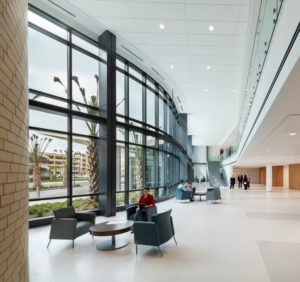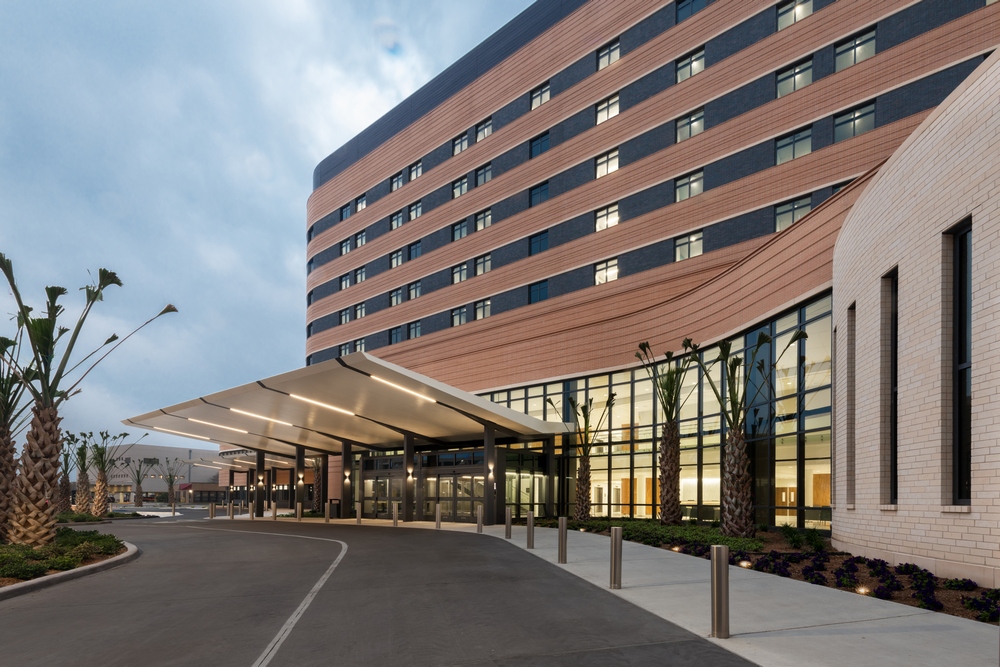Many hospitals expend an extensive amount of effort in market vision and strategic planning. From that effort, construction project planning commences with an intense focus on the desired final design and operational functionality of the new planned space. However, one aspect of project planning that may not get enough attention is phase development. Project phasing can severely impact a hospital during construction and negatively impact the construction timeline.
Campuses must continue to grow and change to meet patient demands, but construction growing pains may be detrimental to progress if not properly orchestrated. Changing the design of the campus can potentially impact entry and administration, emergency room access, staff parking, visitor parking and workflow within each department. Any on-campus construction project must carefully plan impacts to the surrounding campus and mitigate the appearance of change, all while providing consistency for patients, staff and visitors. Therefore, phasing cannot be just a schedule-related task for the contractor to figure out alone. Too many healthcare facilities are hindered during construction phases where better phase planning would have minimized operational impacts.
The following best practices will help hospitals maintain their level of care and employee satisfaction throughout construction.

Integrate phasing discussion within schematic design review
- Partner with a contractor early in the process to receive budgeting and scheduling information to help the team find good solutions to meet the hospital’s needs. In addition, the contractor will provide a unique perspective to assist the design team in achieving the owner’s goals. On a project with multiple renovation areas or if early occupancy of any portion of the new construction is required, ensure the project team understands this intent as early in the design process as possible.
- Adding a phased turnover can complicate mechanical, electrical, plumbing and life safety system design and therefore must be planned early. As an example, reuse of mechanical devices, electrical panels or pneumatic tube stations may be planned at the design level, but the phasing must be planned such that it first alleviates the need for those reused items prior to salvaging them for construction. If the team understands this intent, they may be able to prevent coordination issues amongst reused items across separate phases.
Understand + document occupied area move plan
- When renovating existing spaces, perform an audit or enlist the help of the project team to confirm existing staff and/or patients within the space. Understanding what space is available is critical when temporarily shifting departments to accommodate a phased renovation. Construction delays may occur if occupied spaces are incorrectly relied on for renovation projects. The hospital leadership team may not know who has “moved in” to spaces that they thought were supposed to be “empty.” In addition, the audit should include any facility equipment, as well as medical equipment that may need to be relocated or planned around in the new design.
- When healthcare services, such as a lab or mammogram room, cannot shut down for the renovation, temporary provisions should be planned early, as many times they require some construction for temporary occupancy. Also, consider that temporary provisions will need to be made in vacant spaces to avoid conflicts with construction or hospital operations.
Impacts to life safety systems require special attention
- The design team should be aware of existing fire barriers, smoke compartments and other life safety components impacted by the renovation. Documentation for impacts or alterations to existing life safety walls, egress paths, sprinkler systems, standpipes, fire alarm, exit signage, etc., should be maintained by the facility and provided to the design team to ensure the “during construction” plan meets code requirements. This documentation should be reviewed with the local authority having jurisdiction for compliance.
- The design team will need help from the contractor, facility safety team and other hospital stakeholders who utilize the area or space to ensure these plans are accurate and achievable. If the project team does not address these plans early and with clear expectations for each team member, there is a higher risk of construction delays or threat of implementing a plan that unnecessarily burden’s the hospital.
Weekly construction team meetings
- Schedule weekly standing meetings with the contractor, infection prevention, facilities and key department stakeholders to discuss upcoming work that may impact the hospital. Request the contractor lead this effort by submitting written Area Disruption Notices, Shutdown Requests or Work Plans prior to working in any occupied or public areas (or on any system that could impact an occupied or public area).
- Include an ongoing update for any projects that may impact hospital operations. Having the contractor provide up-to-date information on expectations for noise, smells, vibrations, deliveries, work hours, etc., will allow department leaders to communicate this information to staff. Also, consider how this information gets disseminated down to staff. Many times, employees are more satisfied over the course of a construction project if kept apprised on progress and feel they have a voice when it comes to operational needs. In addition, marketing can be engaged as needed for any disruptions that may impact campus visitors.
Contractor-provided “micro” phasing plans
- Require the contractor to submit “micro” phasing plans for review and approval prior to any work that will be in public or occupied areas. In most cases, to meet Infection Control Risk Assessment requirements, the contractor will need to install plastic partitions just to build construction barricades. This means the contractor will need additional room for a short amount of time to build temporary partitions. Pre-walk any renovation areas with the contractor and ask them to mark on the floor with tape (as allowed by infection prevention personnel) where they plan on building their temporary partitions. Require the “micro” phasing plan to include estimated durations, work hours, anticipated start and finish dates and worker/material access paths and protocols.
Main entry attention
- Understanding how the project impacts the main entrance to a facility is vital to subsequent phase planning. If alternative entry accommodations are required, those will need to be established early in design. It is likely the alternative entry will relocate other procedures that will need to further relocate. This cascading effect will need to be fully vetted to ensure all relocated resources are properly and adequately transferred. The next step is to consider how this adjusts internal wayfinding. Then, the analysis needs to continue to exterior wayfinding to the extent that any departmental entrances or services may have been relocated. This may include adjustments to directional signage, as well as relocating illuminated department markers. The aforementioned items will guide foot traffic to the proper location, but vehicle traffic will need to be considered as well.
- When construction is undertaken, it creates an environment that can produce or track dirt and debris. Hold contractors accountable for making the site look professional. Fences and gates should be in good repair and maintained to provide a positive appearance of the facility. Gates should be closed when not being used so that visitors are not confused about public access points. Signage should clearly delineate the construction area.
- Patient drop-off locations also tend to have an impact on the health and patient satisfaction rating. Altering the drop-off procedure may require a secondary location to be established or using valet services. Finally, the impact to patient and visitor parking must be evaluated. Access to parking and designated walk path to the facility will impact vehicle traffic flow adjacent to the campus, which may ultimately impact hospital census. If parking is too far, wayfinding is too complicated, or inclement weather is too impactful, patients may choose other healthcare provider options. It may be necessary to offer complimentary valet services, free parking or transportation to assist the less able bodied.
Don’t let unplanned project phasing become a hindrance to a timely project completion, day-to-day operations or create dissatisfaction with employees and visitors. By communicating the vision early – including phasing – and assigning proper responsibilities to the project team and hospital staff, facilities will be better suited to mitigate growing pains during expansions or renovations.
Photos courtesy of James Steinkamp Photography.





